Chapter: Mechanical : Heat and Mass Transfer : Convection
Solved Problems - Heat and Mass Transfer - Convection
1.
Air at 20C at atmospheric pressure flows over a flat plate at a velocity of 3
m/s. if the plate is 1 m wide and 80C, calculate the following at x = 300 mm.
1. Hydrodynamic boundary layer thickness,
2. Thermal boundary layer thickness,
3. Local friction coefficient,
4. Average friction coefficient,
5. Local
heat transfer coefficient
6. Average
heat transfer coefficient,
7. Heat
transfer.
Given: Fluid
temperature T¥ =
20°C , Velocity U = 3 m/s
Wide
W = 1 m
Surface temperature Tw = 80°C
Distance x = 300 mm = 0.3 m
Solution: We
know

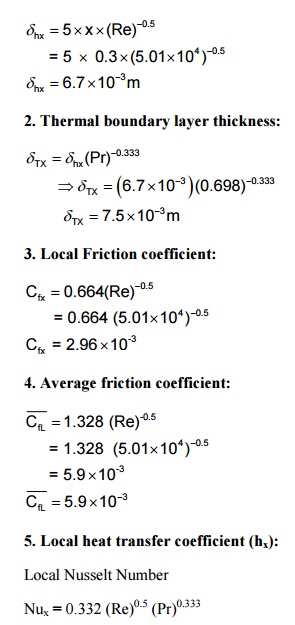
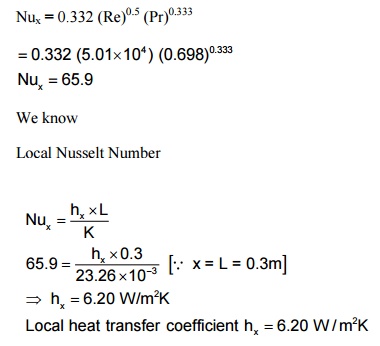
6. Average heat transfer coefficient
(h):
h =2 ´hx =2 ´6.20
h =12.41 W / m2K
7. Heat transfer:
We know that,
Q =h A(Tw
-T¥)
= 12.41´(1 ´0.3) (80-20) Q = 23.38 Watts
2. Air at 40°C is flows over a flat plate of 0.9 m at a velocity
of 3 m/s. Calculate the following:
1. Overall
drag coefficient
2. Average
shear stress,
3. Compare
the average shear stress with local shear stress (shear stress at the trailing
edge)
Given:
Fluid temperature T¥ = 40°C
Length L = 0.9 m
Velocity
U = 3 m/s.
Solution:
Properties of air at 40°C:
r=1.128 Kg/m3
n=
16.96 ´10-6 m2 / s Pr =0.699
K =
26.56 ´10-3 W/mK
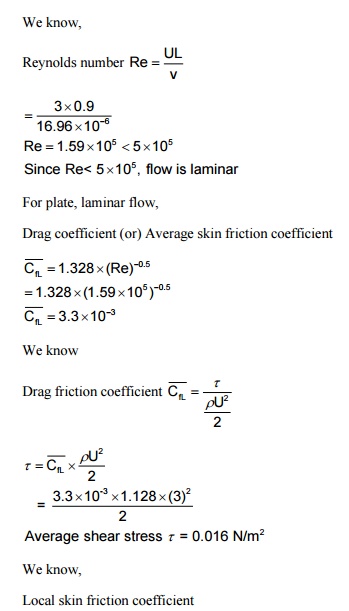
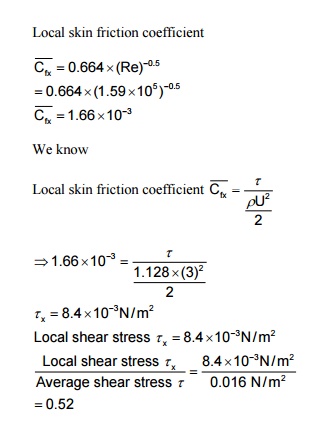
3. Air at 20oC flows over a flat
plate at 60oC with a free stream velocity of 6 m/s. Determine the
value of the average convective heat transfer coefficient up to a length of 1 m
in the flow direction.
in the flow direction. (AU2013)
Given:
Fluid temperature Tinf = 20oC
Plate temperature Tw = 60oC
Velocity U = 6 m/s
Length L = 1 m
To find: Average heat transfer coefficient
Solution: We know
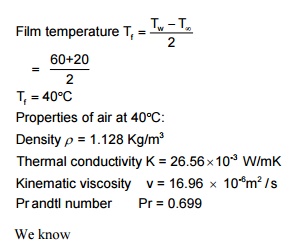
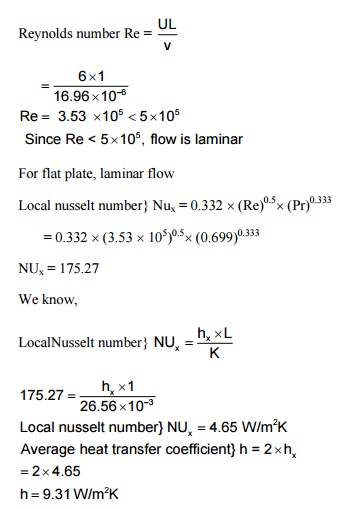
Local nusselt number} NUx =4.65 W/m2K Average heat transfer coefficient}
h = 2 ´hx =2 ´4.65
h =9.31 W/m2K
4. Engine oil flows through a 50 mm
diameter tube at an average temperature of 147°C.
The flow velocity is 80
cm/s. Calculate the average heat transfer coefficient if the tube wall is
maintained at a temperature of 200°C
and it is 2 m long.
Given:
Diameter D
= 50 mm = 0.050 m
Average temperature Tm= 147°C
Velocity U= 80 cm/s = 0.80 m/s
Tube wall temperature Tw= 200°C
Length L= 2m
To find: Average
heat transfer coefficient (h)
Solution: Properties
of engine oil at 147°C
r=
816 Kg/m3 n= 7 ´10-6 m2 / s Pr = 116
K = 133.8 ´10-3 W/mK
We know
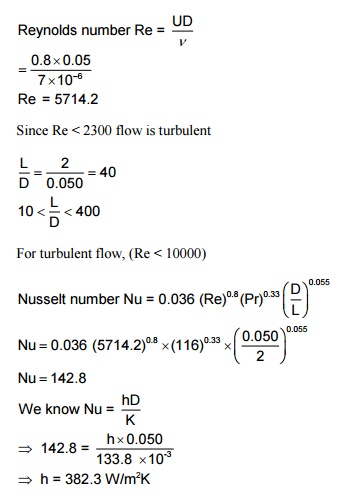
5. A thin 100 cm long
and 10 cm wide horizontal plate is maintained at a uniform temperature of 150°C in a large tank full of water at 75°C. Estimate the rate of heat to be supplied to the
plate to maintain constant plate temperature as heat is dissipated from either
side of plate.
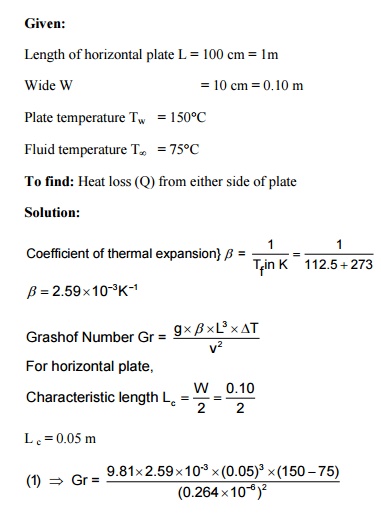
Gr =
3.41´109
Gr
Pr = 3.41´109 ´1.55
Gr Pr = 5.29 ´109
Gr Pr value is in between 8 ´106 and 1011
i.e., 8 ´106<
G r Pr < 1011
For horizontal plate, upper surface
heated:
Nusselt number Nu = 0.15 (Gr Pr)0.333
Þ Nu =
0.15 [5.29 ´109 ]0.333+
Þ Nu =
259.41
We know that,
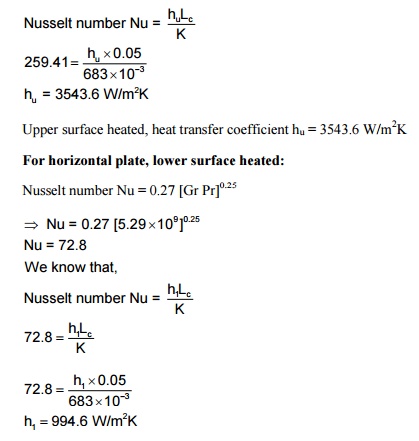
Lower surface heated, heat transfer coefficient h1
= 994.6 W/m2K
Total heat transfer Q = (hu + h1)
´A ´DT
= (hu
+ h1) ´W ´L ´(Tw
- T¥)
=
(3543.6 + 994.6) ´0.10 ´(150
–75) Q = 34036.5 W
6. For a particular
engine, the underside of the crank case can be idealized as a flat plat measuring
80 cm ´20 cm. The engine runs
at 80 km/hr and the crank case is cooled by air flowing past it at the same
speed. Calculate the loss of heat from the crank case surface of temperature 75°C to the ambient air temperature 25°C. Assume the boundary layer becomes turbulent from
the loading edge itself.
Given: Area
A = 80 cm ´20 cm
= 1600 cm2 = 0.16m2
Velocity U = 80 Km/hr
=80 ´10 3 / m
3600s
=22.22 m/s
![]()
Surface temperature Tw =75 C°
Ambient air temperature T¥ =25 C°
Flow is turbulent from the leading edge, flow is
fully turbulent.
To find:
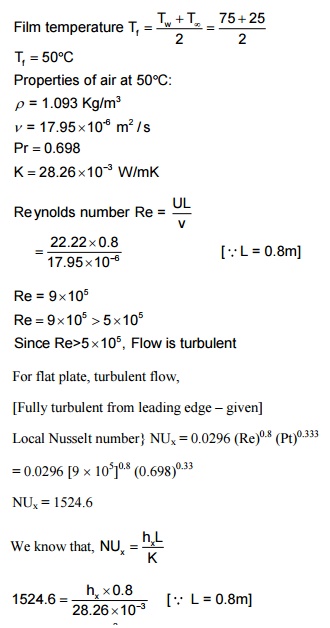
hx =53.85
W/m2K
Local heat transfer coefficient} hx =
53.85 W/m2K
For turbulent flow, flat plate
Average heat transfer
coefficient} h = 1.24 hx h = 1.24 ´53.85
h = 66.78 W/m2K
We know,
Heat loss Q = h A (Tw
- T¥) = 66.78 ´0.16 (75 –25)
Q = 534.2 watts.
Related Topics